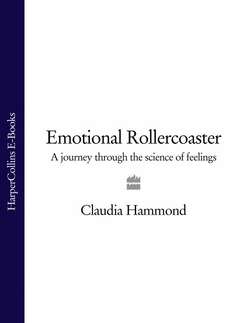Читать книгу Emotional Rollercoaster: A Journey Through the Science of Feelings - Claudia Hammond - Страница 26
Three Disgust
ОглавлениеThe audience sits in silence in a converted warehouse in East London. Although it’s a cold November night, waiters further up Brick Lane stand outside on the street, trying to persuade passers-by to choose their particular curry house. But in the warehouse eating is the last thing anyone would want to do. Out of 2,000 people who tried, these are the lucky 300 who succeeded in getting tickets. A few watch anxiously as a man comes onto the stage wearing the curious combination of a black Fedora hat and surgeon’s scrubs. His name is Professor Gunther von Hagens. After a short introduction his assistants wheel in a long, sheet-covered lump on a trolley. The professor draws back the white cover to reveal the dead body of a man with skin which looks as though it could be made from plastic. The professor walks over to a side-table on which is a silver tray lined up with implements, ranging in size from the smallest knife to a hacksaw. He selects a scalpel, turns back to the body, leans over the man’s breastbone and puts the blade into contact with the skin. He presses down firmly and slices down through the skin. The audience wince as one, imagining the knife cutting through their own flesh. Surprisingly there’s no blood, just a slow trickle of thick orange liquid, like the orange congealed fat left behind in a roasting tin. This is the first public autopsy to be held in Britain for 170 years and in addition to the live audience, millions are watching on television. Professor von Hagens explains that he’s making what’s known as a Y-cut, slicing across the chest and down the centre of the torso. The man died at the age of seventy-two after drinking two bottles of whisky a day and smoking heavily for years. As the chest is opened the skin is peeled back on either side of the cut to reveal layers of fat. The heart and lungs are extracted and carefully placed in silver dishes lined up on the side-table. Like waiters at a banquet, assistants stand in a line nearby, ready to pass a dish when required for the next body part. Eventually just one dish remains empty. It’s time for the brain.
An assistant holds the man’s head still, while von Hagens carefully cuts around the head from ear to ear, loosens the skin enough to slide his hands in behind it and peels back the skin to expose the skull. Taking a hacksaw, he begins grinding his way into the skull, explaining to the audience, as he cuts, that due to the skull’s three layers, this can take some time. When he hears a change in tone he knows he’s through. ‘I am about to take the brain out,’ he calmly announces, as though it’s a cookery demonstration. The brain comes away surprisingly easily. He simply picks it up and lifts it out without resistance, like a walnut out of a shell. Nobody in the audience speaks. Their brows furrow and they lift their hands up to their faces, covering their mouths and half-masking their eyes. They are experiencing disgust.
Although it is such a basic emotion, disgust is often forgotten; if people are asked to list some common emotions it’s usually a long time before disgust is suggested. Yet of all the psychologists I’ve met who research different emotions, those who study disgust seem to do so with a particular passion. They told me that they have learned one thing, however, and the same applies here: however fascinating disgust might be, if you want to enjoy your food it’s not a good idea to read about disgust while you are eating.
There is one way in which disgust differs from many other emotions: feelings of disgust always have a clear cause. You can’t wake up one day feeling generally disgusted in the same way that you might feel generally sad. There has to be an object of your disgust and, as we’ll see, it’s these objects which provide clues as to the purpose of this strange emotion.
The loos at the Glastonbury Festival are infamous. By the end of the weekend after thousands of people have used them, they get very full. The story goes that every year, on the last day of the festival the same trick is played on one very unlucky toilet user. A group of people wait until a man has locked himself into the cubicle and then they tip over the entire box so that the unfortunate inhabitant is trapped lying in the contents of the now emptied toilet.
Just hearing about this story may well provoke a physical response in you. It certainly would for the victim of the trick. Disgust is a particularly visceral emotion. It can make you shudder, salivate, feel physically sick, retch and, at its most extreme, vomit. The facial expression for disgust is particularly distinctive: the nostrils narrow, the upper lip rises high, the lower lip lifts and protrudes slightly, the cheeks rise, the brows lower creating crow’s feet beside the eyes and the sides of the nostrils ascend, causing the sides of the nose to wrinkle. When a person is disgusted other people can tell exactly what they are feeling from those sneering lips. This is the disgust face and it appears very early in life.
